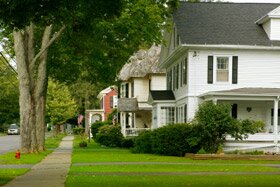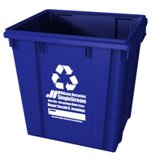Energy
 Carbon Footprint Calculators
Carbon Footprint Calculators
Have you ever wondered how much carbon dioxide (CO2) you release into the environment? There are a number of calculators online that can help estimate your carbon footprint. These calculators will ask you to fill in a wide range of data, such as where you live, what you eat, and how you get around. They may also ask you how much you spend per month on energy; this data is used to calculate your usage based on national or regional average prices. The calculators then estimate your CO2 emissions or carbon footprint based upon the data given.
Some calculators are more complex or focus on different parameters than others. Listed below are a few of the more user-friendly carbon footprint calculators available to consumers.
- U.S. EPA Household Emissions Calculator
- Global Footprint Network: Footprint Calculator
- Carbon Footprint Ltd
- The Nature Conservancy Carbon Calculator
EmPower New York
Low income households (households with income below 60% of state median income) are eligible for free on-site energy use education and strategies for managing their energy costs through the EmPower New York program. Administered by NYSERDA, the energy efficiency services are delivered by private contractors and participating weatherization agencies, all of whom are Building Performance Institute accredited. Visit NYSERDA’s page on EmPower New York for more information.
Federal Tax Credits for Consumer Energy Efficiency
If you have bought or recently installed a solar thermal, solar photovoltaic, geothermal, or small wind turbine system, you may be eligible for a 2012 federal tax credit. For a complete list of eligible systems and how to apply, visit the ENERGY STAR website.
Home Energy Assistance Program (HEAP)
This federally funded program assists low-income New Yorkers with the cost of heating their homes. HEAP may help you pay for electricity, propane, natural gas, wood, oil, kerosene, coal, or any other heating fuel. The HEAP emergency benefit assists qualifying low-income New Yorkers who are facing a heat or heat related emergency and do not have the resources available to resolve the emergency. The heating equipment repair and replacement program is available to help low-income homeowners repair or replace furnaces, boilers, and other direct heating components necessary to keep the home's primary heating source functional. To see if you qualify for assistance or how you can apply, visit the HEAP webpage.
Home Performance with ENERGY STAR®
Have an expert show you how your home is wasting energy and money—and how you can fix it. Keep your hard-earned energy dollars while making your home more comfortable with the Home Performance with ENERGY STAR® program offered by the New York State Energy Research and Development Authority (NYSERDA). Through this program, a Home Performance with ENERGY STAR® contractor will pinpoint the problems in your home and propose cost-effective solutions. Low interest financing and cash incentives are available to pay for the work. Visit www.GreenCapitalRegion.org to download an application and learn more.
Residential High-Efficiency Natural Gas Heating Rebate Program
National Grid offers rebates and incentives to New York residents that install energy-efficient equipment. A variety of boilers, furnaces, and insulation packages qualify for rebates of up to $450. New equipment installed between 1/1/15 to 12/31/15 is eligible for a rebate contingent upon availability of funds. Learn more at National Grid's website.
Weatherization Assistance Program (WAP)
The Weatherization Assistance Program (WAP) enables low-income families to permanently reduce their energy bills by making their homes more energy efficient. Allocated funds are used to improve energy efficiency by plugging cracks, insulating walls, and installing weather stripping to doors and windows. Families receiving weatherization services see their annual energy bills reduced by an average of about $437, depending on fuel prices. Money is distributed to states from the Department of Energy (DOE). Those with income levels at or below 60% of the state median, senior citizens, those with disabilities, and families with children all qualify for assistance. For more information, visit the national WAP website or the New York State Weatherization Assistance Program.
Waste Reduction
Second Refrigerator Freezer Recycling Turn in Program
National Grid offers a $50 rebate to customers who recycle their spare refrigerator or freezer. Clean, empty equipment can be picked up free of charge for proper recycling, thus keeping the bulky items out of the City’s landfills. For more information or to schedule a pickup, visit their website or call (877) 691-0021.
Single Stream Curbside Recycling
 DGS offers curbside recycling for Albany residents living in single family homes or apartment buildings with 4 or fewer units. A wide range of items are accepted (Adobe .pdf), including paper, #1-#7 plastics, glass, cardboard, and cans. Albany recently moved to a single stream recycling process, so you no longer need to separate recyclables into blue or green bins – either works just fine. Bins are provided free of charge through DGS’ office off Erie Boulevard. Call (518) 434-2489 for assistance. Proof of residency is required.
DGS offers curbside recycling for Albany residents living in single family homes or apartment buildings with 4 or fewer units. A wide range of items are accepted (Adobe .pdf), including paper, #1-#7 plastics, glass, cardboard, and cans. Albany recently moved to a single stream recycling process, so you no longer need to separate recyclables into blue or green bins – either works just fine. Bins are provided free of charge through DGS’ office off Erie Boulevard. Call (518) 434-2489 for assistance. Proof of residency is required.
Backyard Composting
As much as one third of waste sent to the landfill is organic waste that decomposes into methane (a greenhouse gas 20 times more potent than carbon dioxide). Grass clippings, weeds, and a variety of green kitchen waste (vegetables, egg shells and coffee grounds) can be composted in small-scale compost heaps. After the natural cycle of decomposition, the waste is turned into rich, fertile soil that can be used in flower gardens or growing your own produce. Larger material, such as tree branches, is available for curbside pick-up to be used as mulch in the city’s parks. The Capital Region Recycling Partnership has a useful guide on backyard composting (Adobe PDF) for beginners and seasoned veterans.
Transportation
Biking
Biking releases no emissions and is great exercise and recreation. The City's 2009 Albany Bike Plan (Adobe PDF) is a comprehensive plan dedicated to increasing bicycle use across the Capital Region. Additional signs and bike lanes are raising awareness and making it considerably easier for commuters to give up their cars and ride a bike. There are a number of bike trails in the area, as well as numerous bicycle-related organizations and blogs, including the Albany Bicycle Coalition, Troy Bike Rescue, and others.
Mass Transit
The Capital District Transportation Authority operates buses throughout the Capital Region. Using the tools on their website you can search for routes for your commute and find time tables. Using mass transit saves you money on parking, gas and the hassle of driving through traffic. All CDTA buses also have bike racks on the front so that people can take their bikes on the bus with them. Varying levels of payment are available, such as day passes, 10-trips, or monthlies.
Carpool
Carpooling reduces the number of vehicles on our roads, helping lower our greenhouse gas emissions and save on fuel costs. Ipool2 is an excellent resource for finding carpools in the Capital Region. Members can sign up to find others who share their commute, as well as other options including Park & Ride, forming vanpools, and other transit options.
Car Share
If you are looking for the flexibility of a car without having to actually own one, then Capital CarShare is for you. Capital CarShare is a nonprofit organization dedicated to providing convenient, affordable, and sustainable neighborhood transportation. Members of Capital CarShare have 24/7 access to vehicles located in their neighborhoods.
Recommended Resources
Green Made Easy: The Everyday Guide for Transitioning to a Green Lifestyle; Chris Prelitz
Toolbox for Sustainable City Living: A do-it-Ourselves Guide; Scott Kellogg, Stacy Pettigrew, & Juan Martinez
Living Green: A Practical Guide to Simple Sustainability; Greg Horn

